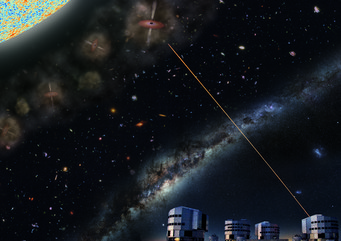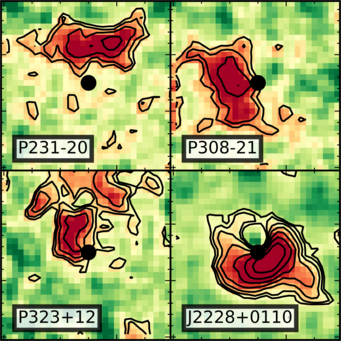Feeding the first supermassive black holes
Extended hydrogen clouds around the first quasars could have sustained the rapid growth of their supermassive black holes.
Supermassive black holes in the centres of galaxies are increasingly found at distances that correspond to an age of the universe of just a few hundred million years. A group of astronomers led by Emanuele Paolo Farina from the Max Planck Institute for Astronomy in Heidelberg has now gained important insights into how these objects may have grown so rapidly. They have detected extended hydrogen clouds around 12 of 31 observed active black holes and their host galaxies, that provide sufficient food. This study was published today in The Astrophysical Journal.

Quasars are among the brightest long-lived objects in the Universe. Therefore, they can be detected even at longest distances in the cosmos. With increasing distance to the observed objects astronomers simultaneously look further and further back into the cosmic past.
Quasars are supermassive black holes with masses of more than one billion suns in the centres of galaxies into which flows gas and other material. This gas heats up so strongly that it radiates extremely brightly.
How did the first supermassive black holes grow?
The first quasars already existed a few hundred million years after the Big Bang. But how these black holes could grow to such large masses in the short period after the first stars existed is one of the greatest astronomical puzzles. In addition, the host galaxies of these quasars form new stars at a rate 100 times higher than the Milky Way and other nearby galaxies. Simulations such as Illustris TNG let astronomers assume that enormous amounts of gas from the intergalactic medium are constantly being exchanged for this purpose, so that the host galaxies of the young quasars should be enveloped in clouds of hydrogen. Previously, only a handful of quasars have been studied in this way. In a paper published earlier this year, a group of scientists led by Alyssa Drake of the Max Planck Institute for Astronomy (MPIA) mapped appreciable quantities of gas around four distant quasars.
Building on the preliminary work of Fabian Walter and Bram Venemans (both MPIA), Emanuele Paolo Farina, a researcher at both the MPIA and the Max Planck Institute for Astrophysics (MPA), initiated the REQUIEM (Reionization Epoch QUasar InvEstigation with MUSE) project. This systematic survey looks for signs of gas clouds around the first quasars that existed when the Universe was no more than a billion years old. An evaluation of the first 31 examined objects led to the detection of 12 extended and surprisingly dense hydrogen clouds. They all enclose the host galaxies and are gravitationally bound to them. The amount of gas is sufficient to feed the activity of the quasars and the increased formation of stars.
Large gas clouds reveal themselves by a glow in UV light.

The astronomers discovered the hydrogen clouds by their characteristic glow in UV light. “The most likely explanation for the shining gas is the mechanism of fluorescence,” Farina explains. “The hydrogen converts the energy-rich radiation of the quasar into light with a specific wavelength, which is noticeable by a glimmer.” Given the large distance and the associated cosmic redshift, earthbound telescopes perceive the glow as red light.
These clouds were detected by the spectrograph MUSE (Multi Unit Spectroscopic Explorer) at the Very Large Telescope (VLT) of the European Southern Observatory (ESO) in Chile. In addition to the spatial distribution of the hydrogen signal, MUSE also measures the velocity of the gas along the line of sight. From the analysis, the scientists conclude that the gas may be flowing radially to the centres of the galaxies, feeding the black holes.
We are just at the beginning.
It is only through the development of new, powerful instruments that we can study the conditions at the beginning of the evolution of the first supermassive black holes and galaxies. “The discovery of these widespread hydrogen gas clouds is an important step towards understanding how these black holes have grown within a few hundred million years since the first stars appeared,” Farina elucidates.
“With the current studies, we are only just beginning to investigate how the first supermassive black holes were able to develop so rapidly,” Alyssa Drake points out, who also contributed to the study. “But new instruments like MUSE and the future James Webb Space Telescope are helping us to solve these exciting puzzles.”
Collaboration
This work is made possible by a collaboration of scientists from the Max Planck Institute for Astronomy in Heidelberg, the Max Planck Institute for Astrophysics in Garching, the Department of Physics of the University of California in Santa Barbara, USA, the INAF Osservatorio di Astrofisica e Scienza dello Spazio in Bologna, Italy, the European Southern Observatory in Santiago, Chile, the Steward Observatory of the University of Arizona in Tucson, USA, the Max Planck Institute for extreterrestrial Physics in Garching, and the INAF Osservatorio Astronomico di Arcetri in Florence, Italy.
MN

